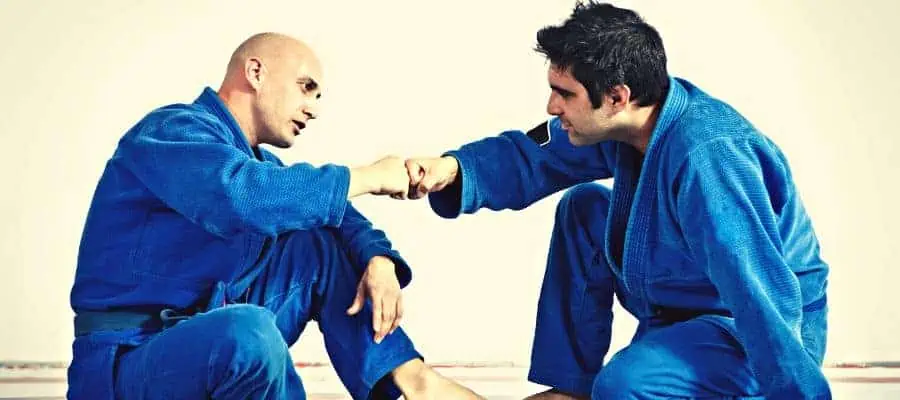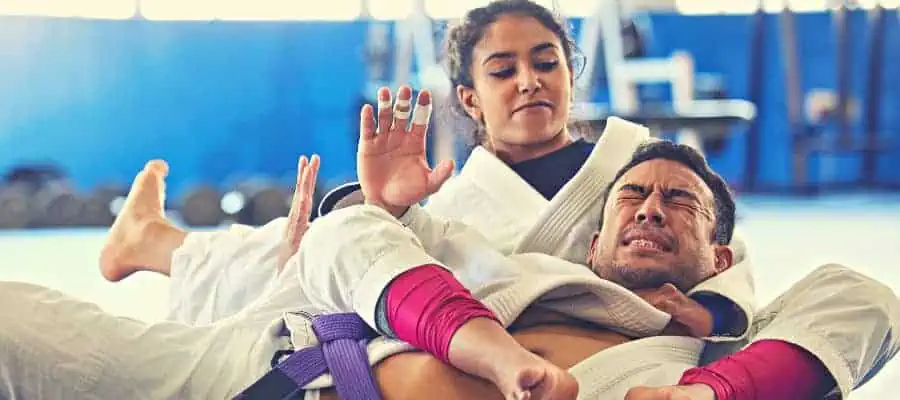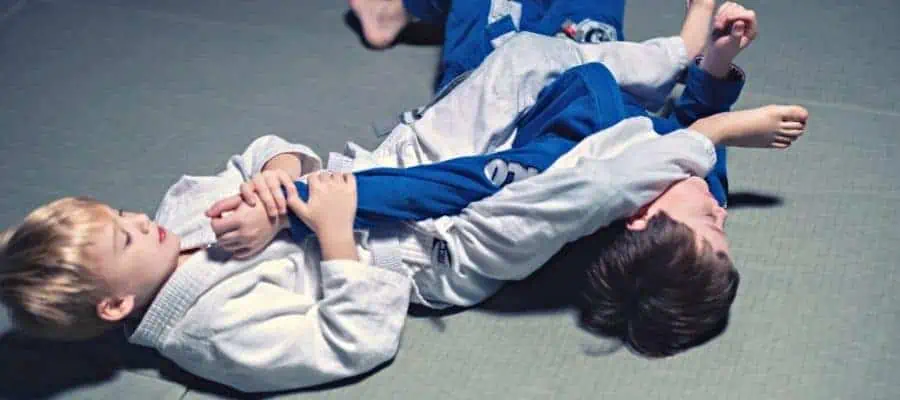Brazilian Jiu-Jitsu is a grappling-based martial art. The focus is on ground fighting and submissions. This is an effective form of self-defense and a great workout. But as a beginner, it can be overwhelming. As a white belt, understanding and focusing on critical areas will be helpful.
So what should BJJ white belts focus on? White belts should focus on several key areas to develop a strong sports foundation by mastering the fundamentals first. This entails positioning, drilling, flexibility, strength, and mental attitude. Additionally, discipline and respect for the instructor and the safety of their training partners.
For beginners, it will be helpful to understand more about each area and how to improve on them. You will find detailed explanations and examples of each point mentioned above. There is more to learn and understand about BJJ. White belts need to understand the basics of the sport and how to progress correctly in their martial arts journey.
BJJ Fundamentals And How To Master Them

Brazilian Jiu-Jitsu, or BJJ, is a martial art that utilizes grappling and ground fighting techniques to control and submit opponents. Unlike other martial arts that rely on striking or brute strength, BJJ emphasizes leverage and technique to overcome larger and stronger opponents.
One of the most important aspects of BJJ is understanding and effectively using various positions to your advantage over your opponent. As a white belt, you will need to explore some of the fundamental positions in BJJ and how they can be used to control and submit an opponent.
The Guard
The guard is a position where one practitioner is lying on their back and using their legs to control and limit their opponent’s movements. From the guard, practitioners can use a variety of sweeps, submissions, and transitions to take the fight to a more advantageous position.
The guard is a versatile position that allows practitioners to control their opponent’s movement, attack with submissions, and set up sweeps to take the top position. It’s a fundamental position that is used by many BJJ practitioners, and it’s a position that is hard to escape from.
Guard players use their legs to control the distance, angle, and pressure, making it hard for their opponent to pass. Additionally, it’s a position that allows the guard player to launch an attack from a safe position.
The Mount
The mount is a position where one practitioner sits on top of their opponent’s chest, with their legs straddling the opponent’s hips. From the mount, practitioners can attack with strikes, chokeholds, and arm locks.
The mount is a dominant position that allows practitioners to control their opponent’s movement and strike with little risk of counter-attack. It’s a position of control, power, and pressure. The mount position is considered one of the most powerful positions in BJJ.
It allows the person on top to strike, choke, and control their opponent’s movement. On the other hand, the person on the bottom should focus on escaping or creating an opportunity to sweep their opponent.
Side Control
Side control is where one practitioner is lying on their side across the opponent’s body, with their hips and legs pinning the opponent’s shoulder and hips to the ground. From the side control, practitioners can attack with arm locks, chokeholds, and strikes. Side control is a stable position that allows practitioners to control their opponent’s movement and attack with submissions.
It’s a position where the person on top has a high level of control over their opponent’s body and movement. They can apply pressure and strike from a safe position. The person on the bottom should focus on escaping or creating an opportunity to sweep their opponent.
Rear Mount
The rear mount is a position where one practitioner sits on their opponent’s back with their legs wrapped around the opponent’s waist. From the rear mount, practitioners can attack with chokeholds, arm locks, and strikes.
The rear mount is a dominant position that allows practitioners to control their opponent’s movement and attack with submissions while minimizing the risk of counter-attack. It’s a position of control and submission. The person on top can choke and arm lock their opponent. In contrast, the person on the bottom should focus on escaping and creating an opportunity to sweep their opponent.
Half Guard
The half guard is where one practitioner is lying on their back with one leg wrapped around the opponent’s leg. From the half guard, practitioners can use their free leg to sweep their opponent, take the top position, or attack with submissions such as kneebars and heel hooks.
The half-guard is a versatile position that allows practitioners to control their opponent’s movement and attack with submissions while minimizing the risk of being swept. It’s a position that is used to defend and launch an attack. The person on the bottom uses their leg to control the distance and pressure, while the person on top should focus.
Understanding and effectively using different positions is a crucial aspect of Brazilian Jiu-Jitsu. These positions are not only the most common but also the most fundamental and essential positions for white belts to learn and master. White belts must understand each position’s advantages and disadvantages and transition between them to maintain an advantage over their opponent.
With consistent training and practice, white belts can master these positions and become skilled and effective BJJ practitioners. These core positions will be the foundation for understanding more advanced positions and concepts in Brazilian Jiu-Jitsu.
Tips Every White Belt Should Know

When starting your BJJ journey, you may feel like you’ve just been thrown into the deep end of a pool filled with sharks. Don’t worry; you’re not alone. We’ve all been there, and these tips should help you navigate the rough waters of BJJ. Here are some tips to help you survive and thrive as a white belt in BJJ.
Learn The Basics
Though this is already covered, it must be stressed more. To build a strong foundation, focus on fundamental techniques such as positions, sweeps, and passing the guard. As a White belt, there is a saying in BJJ that refers to “Position before submission.”
As with all positions, you must focus on staying on top of your opponent. This is namely in the case where energy expenditure is a significant factor. The person on the bottom will usually expend more energy to escape.
Practice Makes Perfect
The importance of drilling builds muscle memory. So drill the techniques you learn in class and off the mat with a willing sparring partner. Repetition is where you build proficiency in BJJ.
Be Patient With Yourself
The pool of knowledge in BJJ is bottomless. It can take time to develop your skills to reach mastery. Though it’s easy to get discouraged if you feel you need to progress. Remember, good things take time. Give yourself time to grow, and with time, you’ll be technically submitting people in no time.
Follow Your Coach’s Instructions
The instructor is there to guide you and help you improve your technique. Pay attention to their demonstrations and feedback. The instructor will easily see mistakes made and where you can improve. They know what they’re talking about and want you to succeed.
At least once a session, asks for feedback from your instructor. If this is not possible, ask the higher belts back at the end of class for feedback.
Stay Humble
Remember that everyone was a white belt at some point. As you learn and progress, it’s effortless to fall into the trap of developing an ego. This may hinder your learning process. Your ego will get in the way of your progress. Keep in mind being a white belt means you may not know everything.
You should always have a thirst for knowledge in your BJJ journey. Every higher belt still has a white belt mentality to openly continue to learn new techniques.
Develop A Positive Attitude
Be curious, experiment, and have fun during your rolls. Though BJJ can be tough. Keep it playful and make friends. Friends with similar goals can turn into rolling partners when you’re not in class together. The more you enjoy BJJ, the more often you will find yourself back at training.
Roll With Different Body Types And Skill Levels
Roll with various skill levels and body types to understand your techniques better. You will understand that specific techniques may better suit different body types. Various skill levels will challenge you to progress in the art and find holes in your techniques.
Consistency And Goals
The key to progress in BJJ is simply showing up every lesson. Don’t miss class, and set a goal for yourself to remain consistent. Apart from this, to stay motivated, have a goal in mind for each training session.
This can be to submit someone at least once during one of your rollings or to escape positions you get stuck in. Build on to each of your goals till you can reach a bigger goal, such as a stripe or entry into a potential tournament. Regardless of the goal, remember that your goal should excite and challenge you.
What Not To Do As A White Belt

There are a few things you should avoid doing if you want to make the most of your training. Avoid getting too cocky or thinking you know it all because the more experienced fighters will quickly humble you. But most importantly, keep your belt tight enough, or you’ll be at risk of cutting off your own circulation and passing out during training. Remember, safety comes first!
Don’t Try To Muscle Through Techniques
Don’t be a brute. Strength rather than technique can lead to poor form and a lack of movement efficiency. You significantly reduce your learning ability if you rely solely on strength for all your techniques. This may make you overlook more efficient movements that could be energy-sparing.
Avoid Comparing Yourself To More Experienced Students
Every person’s journey in BJJ is unique. Comparing yourself to others can lead to discouragement and frustration. Every BJJ practitioner has their own journey toward mastery. Comparing yourself to other students in terms of progression is a waste of time. That time could be better spent perfecting your own skills and techniques.
Refrain From Being Overly Aggressive In Sparring
Being too aggressive can lead to injury for both yourself and your training partner. It’s essential to maintain control and proper technique in sparring. If you continue down this path, you will likely get paid a visit from the gym mat enforcer, who will rough you up, Khabib style.
Don’t Neglect Proper Warm-up And Stretching
Skipping warm-up and stretching can lead to injury and impede progress in training. Stretching will increase your flexibility which is crucial in BJJ, especially for specific movements.
Avoid Trying To Skip Ahead In Your Training
BJJ is a complex art, so take steps in your training. This can lead to gaps in your understanding and technique. Slow down; your body needs to build muscle memory for the movement patterns and techniques. This is especially true when developing a base of fundamental techniques in BJJ.
Don’t Be Afraid To Ask Questions
Asking questions is an essential part of learning. This is especially the case when understanding the techniques and principles of BJJ. Ask the instructor if you need clarification on why certain moves and techniques work. Most instructors will additionally explain the purpose of the movements and give tips and feedback. Remember that their goal is to let you succeed.
Don’t Ignore Proper Etiquette And Respect In The Dojo
Showing respect to your training partners and instructors. Personal hygiene and good etiquette show you respect those you are rolling with to roll with. This includes clipping your nails so as not to scratch your partners and not smell like a dumpster before getting ready for training. Personal hygiene and good etiquette will show respect to your training partners and coach.
Don’t Neglect To Practice And Drill Techniques
Consistent practice and drilling are necessary to progress and improve in BJJ. Namely to build muscle memory and fluency with your techniques. This also allows you to understand the mechanics of each technique better and how to do so more safely compared to live rolls.
Avoid Focusing Too Much On Winning And Competition
BJJ is a journey of self-improvement and progress, not just winning. You may have fewer grappling partners if you constantly aim to win each grappling session. Sometimes you need to focus on other techniques such as your escapes, transitions, or guard. Sometimes you need to be a dummy to assist your partners in developing their own techniques.
Don’t Neglect To Work On Your Physical Fitness And Conditioning
BJJ is a demanding sport. Proper fitness and conditioning are necessary to perform at your best. If you pay attention to your fitness, you may be more easily submitted simply because you are unfit and lack some form of strength.
How Long Should You Be A White Belt In BJJ?

White belt is the first level in Brazilian Jiu-Jitsu and represents a beginner level of understanding of the art. The length of time spent at the white belt level can vary depending on the individual and their training habits.
The Average Length Of Time Spent At The White Belt Level
The average time spent at the white belt level is about 2-3 years. This can vary depending on the individual and their training habits. Some people may progress through the white belt level quicker, while others may take longer.
Factors That Can Affect The Length Of Time Spent At The White Belt Level
Frequency Of Training
Attending classes and drilling techniques will speed up the learning process. You can only expect to develop your skills with one lesson each week. To progress steadily, aim for at least 3 sessions each week.
Learning Style
Some new grapplers may learn faster than others. Some people are just natural, or they may have wrestled in the past and have a better understanding of how to apply techniques. Others may need a step-by-step guide when applying their technique. It is essential to be patient regarding learning new techniques when learning BJJ.
Physical Condition
Some people may be in better physical condition. This implies they can, to a certain degree, have a natural edge over their opponents based on their endurance, weight, height, flexibility, and strength. This is why it is best to improve areas you have control over, such as developing your own body to perform at its best. Enhancing your physical conditioning will minimize injuries and keep you rolling on the mats.
Instructor
A good instructor can recognize when a student is ready for the next belt. Additionally, they will award strips on your white belt as a sign of progression in the art. They will advise what needs to be focused on and highlight mistakes made.
The Importance Of Consistency And Dedication In Progressing Through The Belts
Consistency and dedication are crucial in progressing through the belts in BJJ. Regularly attending classes and drilling techniques helps to solidify the material. This allows for faster progression. Putting in the work outside class will lead to faster progress and a better understanding of the techniques.
The Benefits Of Taking Your Time And Mastering The Fundamentals At The White Belt Level
Taking your time at the white belt level allows for a solid foundation to be built. Mastering the fundamentals at this stage will make learning and executing techniques easier in the future. Additionally, it allows for a better understanding and appreciation of the art.
The Dangers Of Comparing Oneself To Others And Rushing Through The Belt Levels
Comparing oneself to others and rushing through the belt levels can lead to a lack of understanding of the art. Everyone progresses at their own pace, and focusing on one’s own journey is essential. Additionally, rushing through the belt levels can lead to a lack of understanding and mastery of the techniques.
The Role Of The Instructor And Academy In Determining A Student’s Progression Through The Belts
The instructor and academy determine a student’s progression through the belts. A good instructor can recognize when a student is ready for the next belt. They can provide guidance and instruction to help the student progress.
The academy’s culture also plays a role, as some academies may have a stricter belt promotion policy than others. The instructor also makes sure the students understand the techniques and have the mindset to work on the same goal.
Conclusion
Brazilian Jiu-Jitsu is a grappling-based martial art. There is an emphasis on using leverage and technique over brute strength. It is essential to focus on developing a solid foundation as a white belt. Additionally, it is crucial to have discipline and respect for your instructor.
This includes the safety of your training partners. Understanding and effectively using various positions, such as the guard, mount, side control, and rear mount, is crucial in BJJ. These positions can are to control and submit opponents. Mastering them can help you progress correctly.
Recent Posts
What is Manachai's Fighting Style? Unveiling Muay Thai Mastery
Manachai, a celebrated figure in the Muay Thai world, has captivated audiences with his exemplary martial prowess. Hailing from the heartlands of Thailand, his name is synonymous with the art of...
What Was Chamuekpet Hapalang's Fighting Style? Unveiling Techniques
Chamuekpet Hapalang was a renowned figure in the world of Muay Thai (record 200-48-2), embodying a fusion of Muay Bouk and Muay Khao styles. Originating from Thailand, the art of Muay Thai is known...
